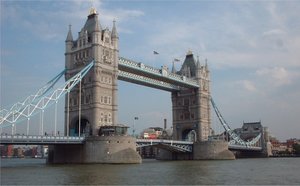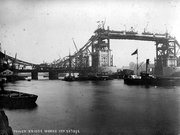Tower Bridge
|
|
Tower Bridge is a bridge in London, England, over the River Thames. It is close to the Tower of London, which gives it its name. It is occasionally incorrectly referred to as London Bridge, which is in fact the next bridge upstream.
| Contents |
Design
Tower_Bridge.JPG
In the second half of the nineteenth century increased commercial development in the East End of London led to a requirement for a new river crossing downstream of London Bridge. However, a traditional bridge could not be built because it would cut off access to the port facilities situated at that time in the Pool of London, between London Bridge and the Tower of London. A tunnel beneath the Thames, the Tower Subway, was opened in 1870, but it could only accommodate pedestrian traffic.
A Special Bridge or Subway Committee was formed in 1876 to find a solution to the river crossing problem. It opened the design of the new crossing to public competition. Over 50 designs were submitted, including one from civil engineer Sir Joseph Bazalgette. However, the evaluation of the designs was surrounded by controversy, and it was not until 1884 that a design submitted by Horace Jones, the City Architect, was finally approved.
Jones' design was for a bascule bridge 800 feet (244 m) in length with two towers each 213 feet (65 m) high, built on piers. The central span of 200 feet (61 m) between the towers is split into two equal bascules or leaves, which can be raised to an angle of 83 degrees to allow river traffic to pass through. Although each bascule weighs over 1,000 tons, they are counterbalanced to minimise the force and time required to raise them, and they can be raised in under one minute. The original hydraulic raising mechanism was powered by pressurised water stored in six accumulators. Water was pumped into the accumulators by steam engines. Although the bridge is raised today electrically, the original steam engines are preserved as a visitor attraction.
Construction
Construction of the bridge started in 1886 and took 8 years, employing 5 major contractors and 432 construction workers. Two massive piers containing over 70,000 tons of concrete were sunk into the river bed to support the construction. Over 11,000 tons of steel provided the framework for the towers and walkways. This was then clad in Cornish granite and Portland Stone, both to protect the underlying steelwork and to give the bridge a more pleasing appearance.
Jones died in 1887, and his chief engineer, Sir John Wolfe-Barry, took over the project. Wolfe-Barry replaced Jones' original mediaeval style of facade with the more ornate Victorian gothic style that makes the bridge such a distinctive landmark.
The bridge was opened in 1894. The official opening ceremony was conducted by the Prince of Wales, the future King Edward VII of the United Kingdom and his wife, Alexandra of Denmark.
Tower Bridge today
The high-level walkways between the towers gained an unpleasant reputation as a haunt for prostitutes and pickpockets and were closed in 1910. They have now been reopened as part of the Tower Bridge Experience, a museum/historical exhibition mostly housed in the bridge's twin towers. The exhibition also includes photos, holograms and a film detailing the build, along with access to the original steam engines that once powered the Bridge bascules, housed in a building close to the south end of the Bridge.
A "Behind the Scenes" tour can be booked in advance, on which it is possible to see the bridge's command centre (where the raising of the bridge is controlled when a vessel passes underneath). The bascules of the bridge are raised around 500 times a year.
Although river traffic is now a fraction of what it used to be, it still takes priority over road traffic. This nearly caused a diplomatic incident in 1997, when the motorcade of United States President Bill Clinton got stuck on Tower Bridge while the bascules were unexpectedly opened.
The bridge sits almost directly above the Tower Subway, the world's first underground tube railway (1870), which, until the Bridge was opened, was the shortest way to cross the river from Tower Hill to Tooley Street.
A new computer system was installed in 2000 to control the raising and lowering of the bascules remotely. Unfortunately this has proved less reliable than desired, resulting in the bridge being stuck in the open or closed positions on a number of occasions (most recently 2 June 2005).
Nearby places
The bridge is near the Tower of London, St Katharine Docks, and Shad Thames.
The north end is near Tower Hill tube station, Tower Gateway DLR station (Docklands Light Railway). The south end is about 10 minutes' walk away from London Bridge station.
To the south of Tower Bridge is Tower Bridge Road which is part of the London Inner Ring Road.
See also
External links
- Official website (http://www.towerbridge.org.uk/)
- Technical article on the building of Tower Bridge (http://www.hartwell.demon.co.uk/tbpic.htm)
- Visitor's guide to Tower Bridge (http://www.tiptown.com/cty/london/tower-bridge.html)


